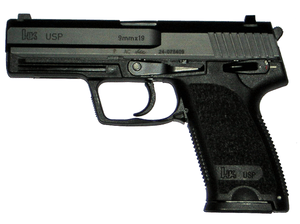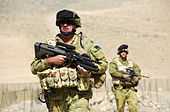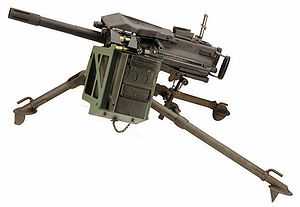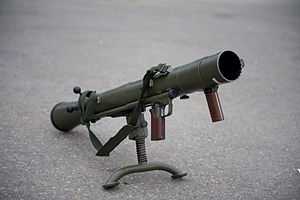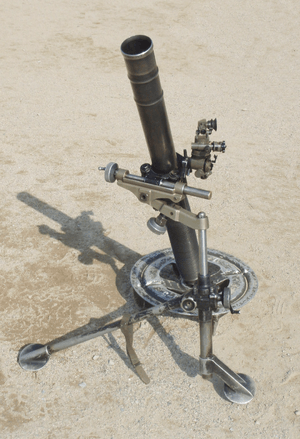
From left to right, a Chinook, Blackhawk and Tiger helicopter
Armoured vehicles

A 1st Armoured Regiment Abrams tank in 2011
-
 M1A1 Abrams - 59 M1A1 Abrams and seven M88 Hercules were purchased to replace the Leopard AS1 in service with the 1st Armoured Regiment. The first M1 equipped sub-units of the regiment became operational in mid-2007. The Abrams is the most powerful vehicle in the Australian inventory. While retaining the gas turbine engines, the Australian Abrams tanks use diesel fuel instead of the kerosene based JP-8 that powers American Abrams tanks. In January 2015 it was announced that a request for a possible military sale of up to six M88A2 Hercules had been submitted by the Australian Government to the United States with a contract value of $47 million dollars. It is believed that this request is to allow the redistribution of the M1A1 and its support vehicles to each Multi-role Combat Brigade as opposed to entirely within the 1st Brigade under Plan Beersheba.[1]
M1A1 Abrams - 59 M1A1 Abrams and seven M88 Hercules were purchased to replace the Leopard AS1 in service with the 1st Armoured Regiment. The first M1 equipped sub-units of the regiment became operational in mid-2007. The Abrams is the most powerful vehicle in the Australian inventory. While retaining the gas turbine engines, the Australian Abrams tanks use diesel fuel instead of the kerosene based JP-8 that powers American Abrams tanks. In January 2015 it was announced that a request for a possible military sale of up to six M88A2 Hercules had been submitted by the Australian Government to the United States with a contract value of $47 million dollars. It is believed that this request is to allow the redistribution of the M1A1 and its support vehicles to each Multi-role Combat Brigade as opposed to entirely within the 1st Brigade under Plan Beersheba.[1]
-
 M113 - The Army has 700 M113 vehicles, which are used in the armoured reconnaissance and armoured personnel carrier roles, primarily by the Army's two mechanised infantry battalions. 431 have been upgraded to M113AS3/4 standard and are currently in service.
M113 - The Army has 700 M113 vehicles, which are used in the armoured reconnaissance and armoured personnel carrier roles, primarily by the Army's two mechanised infantry battalions. 431 have been upgraded to M113AS3/4 standard and are currently in service.
-
 /
/  ASLAV - The Army operates 257 ASLAV-25 vehicles, in a variety of roles including formation reconnaissance, as an infantry fighting vehicle, armoured ambulance or recovery vehicle.
ASLAV - The Army operates 257 ASLAV-25 vehicles, in a variety of roles including formation reconnaissance, as an infantry fighting vehicle, armoured ambulance or recovery vehicle.
-
 Bushmaster PMV - The Army has ordered a total of 1,052 Bushmaster Protected Mobility Vehicles to date, with deliveries commencing in mid-2005. Bushmasters primarily equip the Motorised Infantry 7th Brigade, B Squadron, 3rd/4th Cavalry Regiment also operate armoured vehicles in support of the 3rd Brigade, 1st Combat Engineer Regiment, 2nd Combat Engineer Regiment, and 3rd Combat Engineer Regiment, as well as the heavy weapons and support elements of two mechanised battalions and three light infantry battalions.[2]
Bushmaster PMV - The Army has ordered a total of 1,052 Bushmaster Protected Mobility Vehicles to date, with deliveries commencing in mid-2005. Bushmasters primarily equip the Motorised Infantry 7th Brigade, B Squadron, 3rd/4th Cavalry Regiment also operate armoured vehicles in support of the 3rd Brigade, 1st Combat Engineer Regiment, 2nd Combat Engineer Regiment, and 3rd Combat Engineer Regiment, as well as the heavy weapons and support elements of two mechanised battalions and three light infantry battalions.[2]
Utility and other vehicles
-
 G-Wagon,
G-Wagon,  Land Rover,
Land Rover,  Unimog and
Unimog and  Mack R series - used for transporting stores, equipment and troops.[3][4][5]
Mack R series - used for transporting stores, equipment and troops.[3][4][5]
-
 Nary HMT 400 - The Army has purchased 31 Nary patrol vehicles for use by the SASR, its size and light weight allow it to be ferried by a Chinook helicopter. Its namesake comes from Warrant Officer David Nary who was the first Australian soldier killed during the Iraq War. In addition 89 Supacat HMT Extenda have been ordered as part of the Australian Army's JP2097 Ph 1B (REDFIN) program.[6][7]
Nary HMT 400 - The Army has purchased 31 Nary patrol vehicles for use by the SASR, its size and light weight allow it to be ferried by a Chinook helicopter. Its namesake comes from Warrant Officer David Nary who was the first Australian soldier killed during the Iraq War. In addition 89 Supacat HMT Extenda have been ordered as part of the Australian Army's JP2097 Ph 1B (REDFIN) program.[6][7]
Artillery
-
 L119 Hamel Gun - The 105 mm field artillery is currently used by Reserve units.
L119 Hamel Gun - The 105 mm field artillery is currently used by Reserve units.
 M777 howitzer - Thirty-five 155 mm M777s were ordered as part of the first phase of the Land 17 project to replace the Army's inventory of towed artillery, with initial deliveries beginning in late 2010.[8] An additional 19 guns were purchased in late 2012 instead of the self-propelled guns previously planned, bringing the total order to 54.
M777 howitzer - Thirty-five 155 mm M777s were ordered as part of the first phase of the Land 17 project to replace the Army's inventory of towed artillery, with initial deliveries beginning in late 2010.[8] An additional 19 guns were purchased in late 2012 instead of the self-propelled guns previously planned, bringing the total order to 54.-
 M198 howitzer - Thirty-six 155 mm M198 howitzers are currently used by Reserve artillery regiments.
M198 howitzer - Thirty-six 155 mm M198 howitzers are currently used by Reserve artillery regiments.
Air defence
-
 RBS-70 - The RBS-70 is a man portable SAM system used by the Australian Army for air defence. More sophisticated Bolide missiles have now been purchased.
RBS-70 - The RBS-70 is a man portable SAM system used by the Australian Army for air defence. More sophisticated Bolide missiles have now been purchased.
Aircraft
| Name |
Origin |
Type |
Number |
Photo |
Notes |
|---|
| ARH Tiger |
 France France  Germany Germany |
Armed Reconnaissance Helicopter |
22 |
.jpg) |
Modified and upgraded version of the Tiger HAP. |
| MRH-90 Taipan |
 European Union European Union |
Medium lift/utility helicopter |
27 (41) |
.jpg) |
Replaced the UH-1 Iroquois in 2008, and eventually the Blackhawks. |
| S-70A Blackhawk |
 United States United States |
Medium lift/utility helicopter |
35 |
 |
The Sikorsky S-70-A9 Blackhawk is the Army's primary battlefield lift/utility helicopter. The helicopters were assembled by Hawker de Havilland. Eventually to be replaced by the MRH-90. To be reduced to 18 operational aircraft in 2014–15.[9] |
| CH-47D Chinook |
 United States United States |
Heavy lift helicopter |
7 |
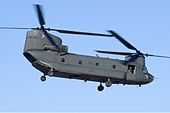 |
|
| CH-47F Chinook |
 United States United States |
Heavy lift helicopter |
1 (7) |
|
|
| OH-58 Kiowa |
 United States United States |
Reconnaissance and battlefield surveillance |
|
 |
It is being replaced by the Tiger armed reconnaissance helicopter. |
| AAI RQ-7 Shadow |
 United States United States |
Reconnaissance and battlefield surveillance |
18 |
|
|
| ScanEagle |
 United States United States |
Reconnaissance and battlefield surveillance |
|
|
|
Infantry weapons

F88S-A1 Austeyr, shown fitted is:
- a standard issue carry handle/1.5x power sight,
- M203 grenade launcher
- and an
AN/PEQ-2 night aiming device.
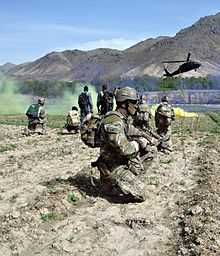
SR-25 rifle, Heckler & Koch USP sidearm and Multicam uniform.
- Assault rifles and carbines
-
 /
/  F88 Austeyr - a derivative of the Austrian Steyr AUG STG-77 assault rifle. It is the ADF's standard individual weapon, which replaced the L1A1 SLR and the M16A1 rifle from front-line service in the late 1980s. The rifle uses an Australian 5.56x45mm cartridge with a modified propellant. According to the ADF, the modified bullet is more accurate and goes further but costs more to make. The F88 Austeyr can use the 5.56x45mm NATO round but under continued use, damages the barrel. The rifle has a 508 mm barrel and an integral 1.5x magnified optical sight inside the carry handle. The weapon is manufactured under licence in Australia by Thales Australia (formerly Australian Defence Industries Ltd). Variants include:
F88 Austeyr - a derivative of the Austrian Steyr AUG STG-77 assault rifle. It is the ADF's standard individual weapon, which replaced the L1A1 SLR and the M16A1 rifle from front-line service in the late 1980s. The rifle uses an Australian 5.56x45mm cartridge with a modified propellant. According to the ADF, the modified bullet is more accurate and goes further but costs more to make. The F88 Austeyr can use the 5.56x45mm NATO round but under continued use, damages the barrel. The rifle has a 508 mm barrel and an integral 1.5x magnified optical sight inside the carry handle. The weapon is manufactured under licence in Australia by Thales Australia (formerly Australian Defence Industries Ltd). Variants include:
- F88C Austeyr - carbine variant, fitted with a 407 mm barrel and is normally issued to personnel serving with space constraints and weight constraints (e.g. Cavalry, Light Horse and Paratroopers). It is also currently used by Reserve units but is in the process of being phased out.
- F88S-A1 Austeyr - updated version that is issued to front-line combat infantry units. The rifle has the full length 508mm barrel and has a flat top receiver with a long MILSTD 1913 'Picatinny' rail to accommodate specialised optical devices and accessories.
- F88S-A1C Austeyr - updated 407 mm barreled carbine variant, with a MILSTD 1913 'Picatinny' rail.
- F88S-A2 Austeyr - an evolutionary upgrade of the current rifle to fulfill an operational capability gap. Deliveries of several thousand were completed in late-2009 to selected units for overseas service. Technical improvements in the F88SA2 include: a larger Picatinny Rail on top of the weapon, a modified sight housing, and a side rail mount for a torch and Night Aiming Devices (NAD). The colour of the weapon has also been changed to khaki to reduce the recognition signature.[10] This variant is currently replacing all previous models.
-
 M4A1 Carbine - used by various Australian special forces units. It is also issued to crew members of the Abrams battle tanks and Tiger helicopters. Its official designation in Australia is the M4A5.[11]
M4A1 Carbine - used by various Australian special forces units. It is also issued to crew members of the Abrams battle tanks and Tiger helicopters. Its official designation in Australia is the M4A5.[11]
- Precision rifles
-
 SR-98 - an Australian variant of the bolt action Accuracy International Arctic Warfare rifle, it is the standard-issue sniper rifle in the Australian Army and is chambered for 7.62x51mm. It replaced the Parker Hale Model 82 rifle in the late 1990s. Manufactured under licence in Australia by Thales Australia.
SR-98 - an Australian variant of the bolt action Accuracy International Arctic Warfare rifle, it is the standard-issue sniper rifle in the Australian Army and is chambered for 7.62x51mm. It replaced the Parker Hale Model 82 rifle in the late 1990s. Manufactured under licence in Australia by Thales Australia.
-
 AW50F - the AW50F is the largest-bore variant of the Arctic Warfare sniper rifles suited to the anti-materiel role. It is chambered for the .50 BMG cartridge, and is primarily used with Raufoss Mk211 HEIAP rounds. The AW50F was designed with an Australian-designed and manufactured barrel.
AW50F - the AW50F is the largest-bore variant of the Arctic Warfare sniper rifles suited to the anti-materiel role. It is chambered for the .50 BMG cartridge, and is primarily used with Raufoss Mk211 HEIAP rounds. The AW50F was designed with an Australian-designed and manufactured barrel.
-
 Blaser 93 Tactical 2 - a straight-pull bolt-action sniper rifle chambered in .338 Lapua Magnum. The rifle has been observed in service with special forces and infantry units in Afghanistan.
Blaser 93 Tactical 2 - a straight-pull bolt-action sniper rifle chambered in .338 Lapua Magnum. The rifle has been observed in service with special forces and infantry units in Afghanistan.
-
 Heckler & Koch HK417 - 'Marksman Rifle System' used by infantry and special forces units to fill the gap between a sniper rifle and 5.56mm derivatives.[12]
Heckler & Koch HK417 - 'Marksman Rifle System' used by infantry and special forces units to fill the gap between a sniper rifle and 5.56mm derivatives.[12]
-
 SR-25 - a semi-automatic 7.62 x 51 mm sniper rifle. It has recently been observed in service with reconnaissance and special forces units of the Australian Army. It has seen service in Iraq, Afghanistan and East Timor.
SR-25 - a semi-automatic 7.62 x 51 mm sniper rifle. It has recently been observed in service with reconnaissance and special forces units of the Australian Army. It has seen service in Iraq, Afghanistan and East Timor.
-
 Mk 14 Enhanced Battle Rifle (M14EBR) - small numbers borrowed from American forces[13] were used by Australian special forces in Afghanistan.
Mk 14 Enhanced Battle Rifle (M14EBR) - small numbers borrowed from American forces[13] were used by Australian special forces in Afghanistan.
-
 Barrett M82 - a semi-automatic sniper and anti-materiel rifle chambered in .50 BMG[14]
Barrett M82 - a semi-automatic sniper and anti-materiel rifle chambered in .50 BMG[14]
- Machine guns
-
.svg.png) F89 Minimi - the Army's standard light machine gun chambered for 5.56 × 45 mm NATO. The F89 is also manufactured under licence in Australia by Thales Australia.
F89 Minimi - the Army's standard light machine gun chambered for 5.56 × 45 mm NATO. The F89 is also manufactured under licence in Australia by Thales Australia.
-
.svg.png) Maximi - the 7.62x51mm NATO model of the Minimi is also in limited service.[15]
Maximi - the 7.62x51mm NATO model of the Minimi is also in limited service.[15]
-
.svg.png) FN MAG 58 - the Army's general purpose machine gun chambered for 7.62 × 51 mm NATO. It replaced the M60 machine gun.
FN MAG 58 - the Army's general purpose machine gun chambered for 7.62 × 51 mm NATO. It replaced the M60 machine gun.
-
 Browning M2HB-QCB - heavy machine gun not used at the infantry section level but rather as a heavy support weapon usually mounted on vehicles. It uses the .50 BMG cartridge and has an effective range in excess of 2,000 metres.
Browning M2HB-QCB - heavy machine gun not used at the infantry section level but rather as a heavy support weapon usually mounted on vehicles. It uses the .50 BMG cartridge and has an effective range in excess of 2,000 metres.
Pistols
Submachine guns
Shotguns
| Name |
Origin |
Type |
Calibre |
Photo |
Notes |
|---|
| Remington Model 870 |
 United States United States |
Shotgun |
12-gauge |
 |
Used by both Special Forces and Military Police personnel. |
Grenade launchers
Anti-armour
Mortars
Grenades and anti personnel mines
| Name |
Origin |
Type |
Detonation |
Photo |
Notes |
|---|
| F1 fragmentation hand grenade |
 Australia Australia |
Frag grenade |
Fuse |
 |
Manufactured by Thales Australia. It has a lethal range of 6 m (20 ft) and has a fuse time of 4.5 to 5.5 seconds. |
| M18A1 Claymore Antipersonnel Mine |
 United States United States |
Anti-personnel mine |
Remote |
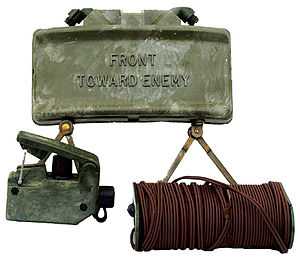 |
It is called an "Anti-Personnel Device" due to the Commonwealth of Australia agreeing not to use mines of any type. |
Bayonets
Combat uniform of the Australian Army

F88A2 rifle and the Australian Multicam Pattern (AMP) combat uniform
There are three major combat uniforms worn by the Australian Defence Force, they are:
- Disruptive Pattern Combat Uniform - DPCU is the standard combat uniform worn in terrains that feature green and brown-shaded flora. The pattern has been in service since the late 1980s.
- Disruptive Pattern Desert Uniform - DPDU is the Desert Combat uniform worn by Australian Defence Force personnel in theatres where the terrain is arid. It uses the same pattern as DPCU, but with the colours changed to suit the desert terrain. This uniform was instituted in the early 2000s, to meet the need for personnel serving overseas in Southwest Asia
- MultiCam - in late 2010, the ADF announced that Multicam will be the standard pattern for all regular Australian Army personnel in Afghanistan after trials were conducted by special operations units. Multicam, it is said, provided "... troops with greater levels of concealment across the range of terrains in Afghanistan – urban, desert and green." Previously, depending upon the terrain, Australian troops had to alternate between green and desert colored DPCUs.[16][17] Furthermore, the Defence Material Organisation has since announced that they had obtained a licence from Crye Associates to locally produce Multicam and for a new uniquely Australian pattern to be developed by Crye to replace DPCU uniforms.[18]
The current issue of DPCU is known as 'DPCU-NIR' - or Disruptive Pattern Combat Uniform - Near Infra-Red. The Defence Science and Technology Organisation has developed materials for use in combat uniforms which will reduce night-vision detection, and it has been integrated into this uniform, which also sports a new cut and shape, the NATO-style front rank epaulette, zip-fastening, sleeve pockets and Velcro tabs.[19]
Future equipment
Infantry weapons
The Army had previously planned on replacing the F88 with the Advanced Individual Combat Weapon (AICW) by 2010–2012. The most notable feature of the AICW is a grenade launcher with 3 stacked rounds that uses electricity to fire off the grenade. The AICW aims to provide the infantry soldier with the ability to fire multiple grenades without having to reload, and to switch between 5.56 mm ballistic rounds and 40 mm grenades without changing sights, trigger or stance, giving the operator more versatility and reduced reaction times in combat. Regardless, the F88 is now likely to remain in service until about 2020, and selected units of the Australian Army are now re-equipping with the F88S-A2.[10]
Armoured Vehicles
In December 2011, the Thales Hawkei PMV (Protected Military Vehicle) was selected as the preferred tender for the Army's requirement of a light 4x4 armored car with a potential order for 1300 vehicles.[20] The seven-tonne Hawkei has been described as a 'baby' variant of the Bushmaster[21] having been developed by the same manufacturer.
Under LAND 400 the ASLAV and M113s will be replaced, with the project to acquire a Combat Reconnaissance Vehicle (CRV), an Infantry Fighting Vehicle (IFV), a Manoeuvre Support Vehicle (MSV) and an Integrated Training System (ITS). The ASLAV fleet is planned to be replaced from 2020, and the M113s from 2025.[22] On 19 February 2015 the tender was opened for the replacement of the ASLAV, listing a requirement for up to 225 armored vehicles to provide the future mounted combat reconnaissance capability.[23] The remaining requirements of the project will be confirmed by the upcoming Defence White Paper; however, it is expected to include an infantry fighting vehicle—a capability currently only partly provided by the in-service M113AS4 Armoured Personnel Carrier—as well as a manoeuvre support vehicle, and an integrated training system.[24] The project is valued at more than $10 billion and is expected to acquire approximately 700 vehicles.[25]
Aircraft
The Army is reorganising its aviation element, through the purchase of 22 Tiger attack helicopters and 30 MRH 90 utility helicopters (30 helicopters out of a total purchase of 46, which will be divided between Army, Fleet Air Arm and a joined MRH 90 training base). Furthermore, seven CH-47F Chinook heavy lift helicopters will be purchased to replace the Army's five remaining CH-47D Chinook helicopters. In addition, the Army will also acquire a number of UAVs (including a number of Boeing ScanEagles and 18 RQ-7 Shadow) which will equip the 20th Surveillance and Target Acquisition Regiment, at Enoggera Barracks, Queensland.[26]
The Army as part of a joint program with the RAN under Air 9000 Phase 7B are seeking future advanced training and light support helicopters. The helicopters being offered by industry are: Eurocopter EC-135 (from Boeing-Thales), Bell 429 (Raytheon-Bell) and Agusta A109 (from BAE-CAE-AgustaWestland).[27]
References
- ↑ "Australia – M88A2 Hercules Heavy Recovery Vehicles" (Press release). Washington, D.C. Defense Security Cooperation Agency. 26 January 2015. Retrieved 4 April 2015.
- ↑ "More vehicles on the way". Army News: The Soldiers' Newspaper (Canberra: Australian Department of Defence). 26 May 2011. p. 16.
- ↑ http://www.army.gov.au/Our-work/Equipment-and-clothing/Vehicles/G_Wagon
- ↑ http://www.defence.gov.au/op/afghanistan/info/general.htm
- ↑ http://www.defenseindustrydaily.com/images/AIR_CH-47_Australian_Unimog_From_HMAS_Kanimbla_lg.jpg
- ↑ "Australian army soon to get Nary vehicles".
- ↑ "Supacat announces Australian operations".
- ↑ Bergmann, Kym (23 October 2010). "Push is on to bring out the big guns". The Australian (News Ltd). Retrieved 4 January 2011.
- ↑ "S-70A-9 Black Hawk Weapons". Defence Materiel Organisation. Department of Defence. Retrieved 8 November 2014.
- ↑ 10.0 10.1 "Thales upgrades Austeyr rifle to meet ADF operational needs". Thales Australia. 29 October 2008. Retrieved 2009-09-23.
- ↑ "New assault rifles for Australian commando force". International Defence Digest. Jane's International Defence Review. 5 Sep 2000. Retrieved 24 August 2012.
The 4th Battalion, Royal Australian Regiment (commando) (4RAR) (Cdo) will receive several hundred Colt M4A5 5.56mm assault rifles ...
- ↑ Juchniewicz, Nathan (21 July 2011). "New weapon to go the distance". Army News: The Soldiers' Newspaper (Canberra: Australian Department of Defence). p. 3. Retrieved 27 August 2011.
- ↑ Armstrong, Dave (2012). "The M14 EBR - a Continuing Evolution". dtic.mil, slide presentation. Crane Division, Naval Surface Warfare Center (NSWC Crane). p. 9. Retrieved 6 June 2012.
The Australian SAS borrowed a quantity of MK 14 MOD 0 Rifles, one of which was used to earn a Victoria Cross by Corporal Ben Roberts-Smith in October of 2010. He had been providing Sniper Cover from the Air when his Assaulting Services were needed on the Ground.
- ↑ Davis, Sgt Mick (December 5, 2013). "Snipers Hit the Mark: Snipers get fired up at SASR concentration in WA". Army (News). Directorate of Defence News. p. 11. Retrieved 23 December 2013.
- ↑ Juchniewicz N.; Manchip J. (12 May 2011). "Gun maximises combat power". Army News: The Soldiers' Newspaper (Canberra: Australian Department of Defence). p. 4. Retrieved 14 May 2011.
- ↑ New combat uniform makes troops job easier, Australian Department of Defence, 19 November 2010.
- ↑ Land Warfare Conference - Minister for Defence Materiel, Australian Department of Defence, 19 November 2010.
- ↑ New defence uniforms on the way, The Sydney Morning Herald, 30 May 2011
- ↑ Cloak of invisibility. Army News 22 April 2004.
- ↑ "Minister for Defence and Minister for Defence Materiel – Project Overlander – LAND 121". Media release. Department of Defence. 12 December 2011. Retrieved 12 March 2012.
- ↑ "First look at Hawkei". bendigoadvertiser.com.au. Bendigo Advertiser. 3 October 2009. Retrieved 14 March 2012.
The baby brother of the Bushmaster, the Hawkei is a seven-tonne vehicle that has the same protection design as the highly successful Bushmaster.
- ↑ "Project LAND 400". Modernization Project. Australian Army. Retrieved 1 March 2015.
- ↑ "Australia officially opens up tender for next-generation light armoured vehicle". Armyrecognition.com. 19 February 2015. Retrieved 21 February 2015.
- ↑ "Minister for Defence – LAND 400 Phase 2 – Mounted Combat Reconnaissance Capability" (Press release). Department of Defence. 19 February 2015. Retrieved 21 February 2015.
- ↑ "South Australia Primed to Build Australian Army Vehicles" (Press release). Government of South Australia. 19 February 2015. Retrieved 1 March 2015.
- ↑ "Army buys 18 Shadow UAVs". Australian Aviation. Phantom Media. 2 August 2010. Retrieved 13 October 2011.
- ↑ "Boeing/Thales settle on EC135 for ADF bid". Australian Aviation Magazine. 30 January 2012. Retrieved 8 May 2012.
External links


 M1A1 Abrams - 59 M1A1 Abrams and seven M88 Hercules were purchased to replace the Leopard AS1 in service with the 1st Armoured Regiment. The first M1 equipped sub-units of the regiment became operational in mid-2007. The Abrams is the most powerful vehicle in the Australian inventory. While retaining the gas turbine engines, the Australian Abrams tanks use diesel fuel instead of the kerosene based JP-8 that powers American Abrams tanks. In January 2015 it was announced that a request for a possible military sale of up to six M88A2 Hercules had been submitted by the Australian Government to the United States with a contract value of $47 million dollars. It is believed that this request is to allow the redistribution of the M1A1 and its support vehicles to each Multi-role Combat Brigade as opposed to entirely within the 1st Brigade under Plan Beersheba.[1]
M1A1 Abrams - 59 M1A1 Abrams and seven M88 Hercules were purchased to replace the Leopard AS1 in service with the 1st Armoured Regiment. The first M1 equipped sub-units of the regiment became operational in mid-2007. The Abrams is the most powerful vehicle in the Australian inventory. While retaining the gas turbine engines, the Australian Abrams tanks use diesel fuel instead of the kerosene based JP-8 that powers American Abrams tanks. In January 2015 it was announced that a request for a possible military sale of up to six M88A2 Hercules had been submitted by the Australian Government to the United States with a contract value of $47 million dollars. It is believed that this request is to allow the redistribution of the M1A1 and its support vehicles to each Multi-role Combat Brigade as opposed to entirely within the 1st Brigade under Plan Beersheba.[1] M113 - The Army has 700 M113 vehicles, which are used in the armoured reconnaissance and armoured personnel carrier roles, primarily by the Army's two mechanised infantry battalions. 431 have been upgraded to M113AS3/4 standard and are currently in service.
M113 - The Army has 700 M113 vehicles, which are used in the armoured reconnaissance and armoured personnel carrier roles, primarily by the Army's two mechanised infantry battalions. 431 have been upgraded to M113AS3/4 standard and are currently in service. /
/  ASLAV - The Army operates 257 ASLAV-25 vehicles, in a variety of roles including formation reconnaissance, as an infantry fighting vehicle, armoured ambulance or recovery vehicle.
ASLAV - The Army operates 257 ASLAV-25 vehicles, in a variety of roles including formation reconnaissance, as an infantry fighting vehicle, armoured ambulance or recovery vehicle. Bushmaster PMV - The Army has ordered a total of 1,052 Bushmaster Protected Mobility Vehicles to date, with deliveries commencing in mid-2005. Bushmasters primarily equip the Motorised Infantry 7th Brigade, B Squadron, 3rd/4th Cavalry Regiment also operate armoured vehicles in support of the 3rd Brigade, 1st Combat Engineer Regiment, 2nd Combat Engineer Regiment, and 3rd Combat Engineer Regiment, as well as the heavy weapons and support elements of two mechanised battalions and three light infantry battalions.[2]
Bushmaster PMV - The Army has ordered a total of 1,052 Bushmaster Protected Mobility Vehicles to date, with deliveries commencing in mid-2005. Bushmasters primarily equip the Motorised Infantry 7th Brigade, B Squadron, 3rd/4th Cavalry Regiment also operate armoured vehicles in support of the 3rd Brigade, 1st Combat Engineer Regiment, 2nd Combat Engineer Regiment, and 3rd Combat Engineer Regiment, as well as the heavy weapons and support elements of two mechanised battalions and three light infantry battalions.[2] G-Wagon,
G-Wagon,  Land Rover,
Land Rover,  Unimog and
Unimog and  Mack R series - used for transporting stores, equipment and troops.[3][4][5]
Mack R series - used for transporting stores, equipment and troops.[3][4][5] Nary HMT 400 - The Army has purchased 31 Nary patrol vehicles for use by the SASR, its size and light weight allow it to be ferried by a Chinook helicopter. Its namesake comes from Warrant Officer David Nary who was the first Australian soldier killed during the Iraq War. In addition 89 Supacat HMT Extenda have been ordered as part of the Australian Army's JP2097 Ph 1B (REDFIN) program.[6][7]
Nary HMT 400 - The Army has purchased 31 Nary patrol vehicles for use by the SASR, its size and light weight allow it to be ferried by a Chinook helicopter. Its namesake comes from Warrant Officer David Nary who was the first Australian soldier killed during the Iraq War. In addition 89 Supacat HMT Extenda have been ordered as part of the Australian Army's JP2097 Ph 1B (REDFIN) program.[6][7] L119 Hamel Gun - The 105 mm field artillery is currently used by Reserve units.
L119 Hamel Gun - The 105 mm field artillery is currently used by Reserve units. M777 howitzer - Thirty-five 155 mm M777s were ordered as part of the first phase of the Land 17 project to replace the Army's inventory of towed artillery, with initial deliveries beginning in late 2010.[8] An additional 19 guns were purchased in late 2012 instead of the self-propelled guns previously planned, bringing the total order to 54.
M777 howitzer - Thirty-five 155 mm M777s were ordered as part of the first phase of the Land 17 project to replace the Army's inventory of towed artillery, with initial deliveries beginning in late 2010.[8] An additional 19 guns were purchased in late 2012 instead of the self-propelled guns previously planned, bringing the total order to 54. M198 howitzer - Thirty-six 155 mm M198 howitzers are currently used by Reserve artillery regiments.
M198 howitzer - Thirty-six 155 mm M198 howitzers are currently used by Reserve artillery regiments. RBS-70 - The RBS-70 is a man portable SAM system used by the Australian Army for air defence. More sophisticated Bolide missiles have now been purchased.
RBS-70 - The RBS-70 is a man portable SAM system used by the Australian Army for air defence. More sophisticated Bolide missiles have now been purchased..jpg)
.jpg)





 /
/  F88 Austeyr - a derivative of the Austrian Steyr AUG STG-77 assault rifle. It is the ADF's standard individual weapon, which replaced the L1A1 SLR and the M16A1 rifle from front-line service in the late 1980s. The rifle uses an Australian 5.56x45mm cartridge with a modified propellant. According to the ADF, the modified bullet is more accurate and goes further but costs more to make. The F88 Austeyr can use the 5.56x45mm NATO round but under continued use, damages the barrel. The rifle has a 508 mm barrel and an integral 1.5x magnified optical sight inside the carry handle. The weapon is manufactured under licence in Australia by Thales Australia (formerly Australian Defence Industries Ltd). Variants include:
F88 Austeyr - a derivative of the Austrian Steyr AUG STG-77 assault rifle. It is the ADF's standard individual weapon, which replaced the L1A1 SLR and the M16A1 rifle from front-line service in the late 1980s. The rifle uses an Australian 5.56x45mm cartridge with a modified propellant. According to the ADF, the modified bullet is more accurate and goes further but costs more to make. The F88 Austeyr can use the 5.56x45mm NATO round but under continued use, damages the barrel. The rifle has a 508 mm barrel and an integral 1.5x magnified optical sight inside the carry handle. The weapon is manufactured under licence in Australia by Thales Australia (formerly Australian Defence Industries Ltd). Variants include:
 M4A1 Carbine - used by various Australian special forces units. It is also issued to crew members of the Abrams battle tanks and Tiger helicopters. Its official designation in Australia is the M4A5.[11]
M4A1 Carbine - used by various Australian special forces units. It is also issued to crew members of the Abrams battle tanks and Tiger helicopters. Its official designation in Australia is the M4A5.[11] SR-98 - an Australian variant of the bolt action Accuracy International Arctic Warfare rifle, it is the standard-issue sniper rifle in the Australian Army and is chambered for 7.62x51mm. It replaced the Parker Hale Model 82 rifle in the late 1990s. Manufactured under licence in Australia by Thales Australia.
SR-98 - an Australian variant of the bolt action Accuracy International Arctic Warfare rifle, it is the standard-issue sniper rifle in the Australian Army and is chambered for 7.62x51mm. It replaced the Parker Hale Model 82 rifle in the late 1990s. Manufactured under licence in Australia by Thales Australia. AW50F - the AW50F is the largest-bore variant of the Arctic Warfare sniper rifles suited to the anti-materiel role. It is chambered for the .50 BMG cartridge, and is primarily used with Raufoss Mk211 HEIAP rounds. The AW50F was designed with an Australian-designed and manufactured barrel.
AW50F - the AW50F is the largest-bore variant of the Arctic Warfare sniper rifles suited to the anti-materiel role. It is chambered for the .50 BMG cartridge, and is primarily used with Raufoss Mk211 HEIAP rounds. The AW50F was designed with an Australian-designed and manufactured barrel. Blaser 93 Tactical 2 - a straight-pull bolt-action sniper rifle chambered in .338 Lapua Magnum. The rifle has been observed in service with special forces and infantry units in Afghanistan.
Blaser 93 Tactical 2 - a straight-pull bolt-action sniper rifle chambered in .338 Lapua Magnum. The rifle has been observed in service with special forces and infantry units in Afghanistan. Heckler & Koch HK417 - 'Marksman Rifle System' used by infantry and special forces units to fill the gap between a sniper rifle and 5.56mm derivatives.[12]
Heckler & Koch HK417 - 'Marksman Rifle System' used by infantry and special forces units to fill the gap between a sniper rifle and 5.56mm derivatives.[12] SR-25 - a semi-automatic 7.62 x 51 mm sniper rifle. It has recently been observed in service with reconnaissance and special forces units of the Australian Army. It has seen service in Iraq, Afghanistan and East Timor.
SR-25 - a semi-automatic 7.62 x 51 mm sniper rifle. It has recently been observed in service with reconnaissance and special forces units of the Australian Army. It has seen service in Iraq, Afghanistan and East Timor. Mk 14 Enhanced Battle Rifle (M14EBR) - small numbers borrowed from American forces[13] were used by Australian special forces in Afghanistan.
Mk 14 Enhanced Battle Rifle (M14EBR) - small numbers borrowed from American forces[13] were used by Australian special forces in Afghanistan. Barrett M82 - a semi-automatic sniper and anti-materiel rifle chambered in .50 BMG[14]
Barrett M82 - a semi-automatic sniper and anti-materiel rifle chambered in .50 BMG[14] .svg.png) F89 Minimi - the Army's standard light machine gun chambered for 5.56 × 45 mm NATO. The F89 is also manufactured under licence in Australia by Thales Australia.
F89 Minimi - the Army's standard light machine gun chambered for 5.56 × 45 mm NATO. The F89 is also manufactured under licence in Australia by Thales Australia..svg.png) Maximi - the 7.62x51mm NATO model of the Minimi is also in limited service.[15]
Maximi - the 7.62x51mm NATO model of the Minimi is also in limited service.[15].svg.png) FN MAG 58 - the Army's general purpose machine gun chambered for 7.62 × 51 mm NATO. It replaced the M60 machine gun.
FN MAG 58 - the Army's general purpose machine gun chambered for 7.62 × 51 mm NATO. It replaced the M60 machine gun. Browning M2HB-QCB - heavy machine gun not used at the infantry section level but rather as a heavy support weapon usually mounted on vehicles. It uses the .50 BMG cartridge and has an effective range in excess of 2,000 metres.
Browning M2HB-QCB - heavy machine gun not used at the infantry section level but rather as a heavy support weapon usually mounted on vehicles. It uses the .50 BMG cartridge and has an effective range in excess of 2,000 metres.
